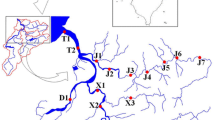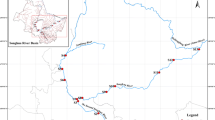Abstract
A cruise was commissioned in the summer of 2009 to evaluate water quality in the Pearl River Estuary (PRE). Chemometrics such as Principal Component Analysis (PCA), Cluster analysis (CA) and Self-Organizing Map (SOM) were employed to identify anthropogenic and natural influences on estuary water quality. The scores of stations in the surface layer in the first principal component (PC1) were related to NH4-N, PO4-P, NO2-N, NO3-N, TP, and Chlorophyll a while salinity, turbidity, and SiO3-Si in the second principal component (PC2). Similarly, the scores of stations in the bottom layers in PC1 were related to PO4-P, NO2-N, NO3-N, and TP, while salinity, Chlorophyll a, NH4-N, and SiO3-Si in PC2. Results of the PCA identified the spatial distribution of the surface and bottom water quality, namely the Guangzhou urban reach, Middle reach, and Lower reach of the estuary. Both cluster analysis and PCA produced the similar results. Self-organizing map delineated the Guangzhou urban reach of the Pearl River that was mainly influenced by human activities. The middle and lower reaches of the PRE were mainly influenced by the waters in the South China Sea. The information extracted by PCA, CA, and SOM would be very useful to regional agencies in developing a strategy to carry out scientific plans for resource use based on marine system functions.
Similar content being viewed by others
References
Astel A, Tsakovski S, Barbieri P, Simeonov V (2007). Comparison of self-organizing maps classification approach with cluster and principal components analysis for large environmental data sets. Water Res, 41(19): 4566–4578
Astel A, Tsakovski S, Simeonov V, Reisenhofer E, Piselli S, Barbieri P (2008). Multivariate classification and modeling in surface water pollution estimation. Anal Bioanal Chem, 390(5): 1283–1292
Cereghino R, Park Y S (2009). Review of the Self-Organizing Map (SOM) approach in water resources. Environ Model Softw, 24(8): 945–947 (Commentary)
Chen J C, Heinke G W, Zhou M J (2004). The Pearl River Estuary Pollution Project (PREPP). Cont Shelf Res, 24(16): 1739–1744
Cheung K C, Leung H M, Wong M H (2008). Metal concentrations of common freshwater and marine fish from the Pearl River Delta, South China. Arch Environ Contam Toxicol, 54(4): 705–715
Çinar O, Merdun H (2009). Application of an unsupervised artificial neural network technique to multivariant surface water quality data. Ecol Res, 24(1): 163–173
Dou L, Du H Y, He J M, You Y H, Zhou Y Z, Liu Z N, Zhu X (2009). Spatial distribution and sources of heavy metals in soil of Dongguan City, Pearl River Delta Economic Zone, Guangdong Province, China. Environ Sci, 29(12): 3496–3502
Duzgoren-Aydin N S (2007). Sources and characteristics of lead pollution in the urban environment of Guangzhou. Sci Total Environ, 385(1–3): 182–195
Hall P O J, Holby O, Kollberg S, Samuelson M O (1992). Chemical fluxes and mass balances in a marine fish cage farm.4. Nitrogen. Mar Ecol Prog Ser, 89: 81–91
Harrison P J, Yin K D, Lee J H W, Gan J P, Liu H B (2005). Physicalbiological coupling in the Pearl River Estuary. Symposium on Coastal Ecosystem Responses to Changing Nutrient Inputs from Large Temperate and Sub-Tropical Rivers, Fujian, PEOPLES R CHINA, 1405–1415
Hodgkiss I J, Lu S H (2004). The effects of nutrients and their ratios on phytoplankton abundance in Junk Bay, Hong Kong. Hydrobiologia, 512(1–3): 215–229
Holby O, Hall P O J (1991). Chemical fluxes and mass balances in a marine fish cage farm. II: Phosphor. Mar Ecol Prog Ser, 70: 263–272
Hu J T, Li S Y (2009). Modeling the mass fluxes and transformations of nutrients in the Pearl River Delta, China. J Mar Syst, 78(1): 146–167
Huang X P, Huang LM, Yue WZ (2003). The characteristics of nutrients and eutrophication in the Pearl River Estuary, South China. Mar Pollut Bull, 47(1–6): 30–36
Kohonen T (1982). Self-organized formation of topologically correct feature maps. Biol Cybern, 43(1): 59–69
Kohonen T (2001). Self-Organizing Maps (3rd ed). Berlin: Springer
Li J, Zhang G, Xu Y, Liu X A, Li X D (2010). Dry and wet particle deposition of polybrominated diphenyl ethers (PBDEs) in Guangzhou and Hong Kong, South China. J Environ Monit, 12(9): 1730–1736
Li K Z, Yin J Q, Huang L M, Tan Y H (2006). Spatial and temporal variations of mesozooplankton in the Pearl River Estuary, China. Estuar Coast Shelf Sci, 67(4): 543–552
Liu S M, Zhang J, Chen H T, Zhang G S (2005). Factors influencing nutrient dynamics in the eutrophic Jiaozhou Bay, North China. Prog Oceanogr, 66(1): 66–85
Lu R S, Lo S L (2002). Diagnosing reservoir water quality using selforganizing maps and fuzzy theory. Water Res, 36(9): 2265–2274
Pereira-Filho J, Schettini C A F, Rörig L, Siegle E (2001). Intratidal variation and net transport of dissolved inorganic nutrients, POC and chlorophyll a in the Camboriu River Estuary, Brazil. Estuar Coast Shelf Sci, 53(2): 249–257
Qiao M, An T C, Zeng X Y, Zhang D L, Li G Y, Sheng G Y, Fu J M, Zhang G X, Guo J (2010). Safety assessment of the source water within the Pearl River Delta on the aspect of organochlorine pesticides contamination. J Environ Monit, 12(9): 1666–1677
Redfield A C, Ketchum B H, Richards F A (1963). The influence of organisms on the composition of seawater. In: Hill M N, ed. The Sea. New York: John Wiley, 26–77
Shrestha S, Kazama F (2007). Assessment of surface water quality using multivariate statistical techniques: a case study of the Fuji river basin, Japan. Environ Model Softw, 22(4): 464–475
Singh K P, Malik A, Mohan D, Sinha S (2004). Multivariate statistical techniques for the evaluation of spatial and temporal variations in water quality of Gomti River (India)–A case study. Water Res, 38(18): 3980–3992
Song M Y, Hwang H J, Kwak I S, Ji C W, Oh Y N, Youn B J, Chon T S (2007). Self-organizing mapping of benthic macroinvertebrate communities implemented to community assessment and water quality evaluation. Ecol Modell, 203(1–2): 18–25
Tao Y X, Hills P (1999). Assessment of alternative wastewater treatment approaches in Guangzhou, China. Water Sci Technol, 39(5): 227–234
Vega M, Pardo R, Barrado E, Deban L (1998). Assessment of seasonal and polluting effects on the quality of river water by exploratory data analysis. Water Res, 32(12): 3581–3592
Wang Y S (2013). Quantitative Marine Ecology-Theory, Method and Practice. Beijing: Science Press
Wei P, Huang L M (2010). Water quality and eutrophication in the Guangzhou Sea Zone of the Pearl River Estuary. Chin J Oceanology Limnol, 28(1): 113–121
Wen WY, Zhang G X, Du WC (1995). A study on water pollution in the Zhujing (Pearl River) Estuary. In: Wong C K, Chu K H, Chen Q C, Ma X L, eds. Environmental Research in Pearl River and Coastal Area. Guangzhou: Guangdong Higher Education Press, 99–108
Wong L A, Chen J, Xue H, Dong L X, Su J L, Heinke G (2003). A model study of the circulation in the Pearl River Estuary (PRE) and its adjacent coastal waters: 1. Simulations and comparison with observations. Journal of Geophysical Research, 108(C5): 249–260
Wu M L, Ling J, Long L J, Zhang S, Zhang Y Y, Wang Y S, Dong J D (2012). Influence of human activity and monsoon dynamics on spatial and temporal hydrochemistry in tropical coastal waters (Sanya Bay, South China Sea). Chem Ecol, 28(4): 375–390
Wu M L, Wang Y S (2007). Using chemometrics to evaluate anthropogenic effects in Daya Bay, China. Estuar Coast Shelf Sci, 72(4): 732–742
Wu M L, Wang Y S, Sun C C, Wang H L, Dong J D, Yin J P, Han S H (2010). Identification of coastal water quality by statistical analysis methods in Daya Bay, South China Sea. Mar Pollut Bull, 60(6): 852–860
Ye L, Cai Q H, Liu R Q, Cao M (2009). The influence of topography and land use on water quality of Xiangxi River in Three Gorges Reservoir region. Environmental Geology, 58(5): 937–942
Yin K D, Qian P Y, Wu MC S, Chen J C, Huang LM, Song X Y, Jian W J (2001). Shift from P to N limitation of phytoplankton growth across the Pearl River estuarine plume during summer. Mar Ecol Prog Ser, 221: 17–28
Zhang J (1996). Nutrient elements in large Chinese estuaries. Cont Shelf Res, 16(8): 1023–1045
Zhao H (1990). Evolution of the Pearl River Estuary. Beijing: Ocean Press
Zhou F, Liu Y, Guo H C (2007). Application of multivariate statistical methods to water quality assessment of the watercourses in northwestern new territories, Hong Kong. Environ Monit Assess, 132(1–3): 1–13
Zhou H Y, Peng X T, Pan J M (2004). Distribution, source and enrichment of some chemical elements in sediments of the Pearl River Estuary, China. Cont Shelf Res, 24(16): 1857–1875
Acknowledgements
This research was supported by the National Natural Science Foundation of China (Grant Nos. 41206082 and 31270528), Natural Science Foundation of Guangdong (Nos. S2013020012823), Scientific Research Project of Guangzhou (No. 15020023), the project of Guangdong Provincial Department of Science and Technology (No. 2012A032100004), the projects of knowledge innovation program of State Key Laboratory of Tropical Oceanography (Nos. LTOZZ1402 and LTOZZ1604), the Key Laboratory for Ecological Environment in Coastal Area, State Oceanic Administation (No. 201507), Key Laboratory of Fishery Ecology and Environment, Guangdong Province (No. LFE-2010-14) and the visiting scholar project of the Chinese Academy Sciences overseas study program.
Author information
Authors and Affiliations
Corresponding author
Rights and permissions
About this article
Cite this article
Wu, M., Wang, Y., Dong, J. et al. Spatial assessment of water quality using chemometrics in the Pearl River Estuary, China. Front. Earth Sci. 11, 114–126 (2017). https://doi.org/10.1007/s11707-016-0585-0
Received:
Accepted:
Published:
Issue Date:
DOI: https://doi.org/10.1007/s11707-016-0585-0




